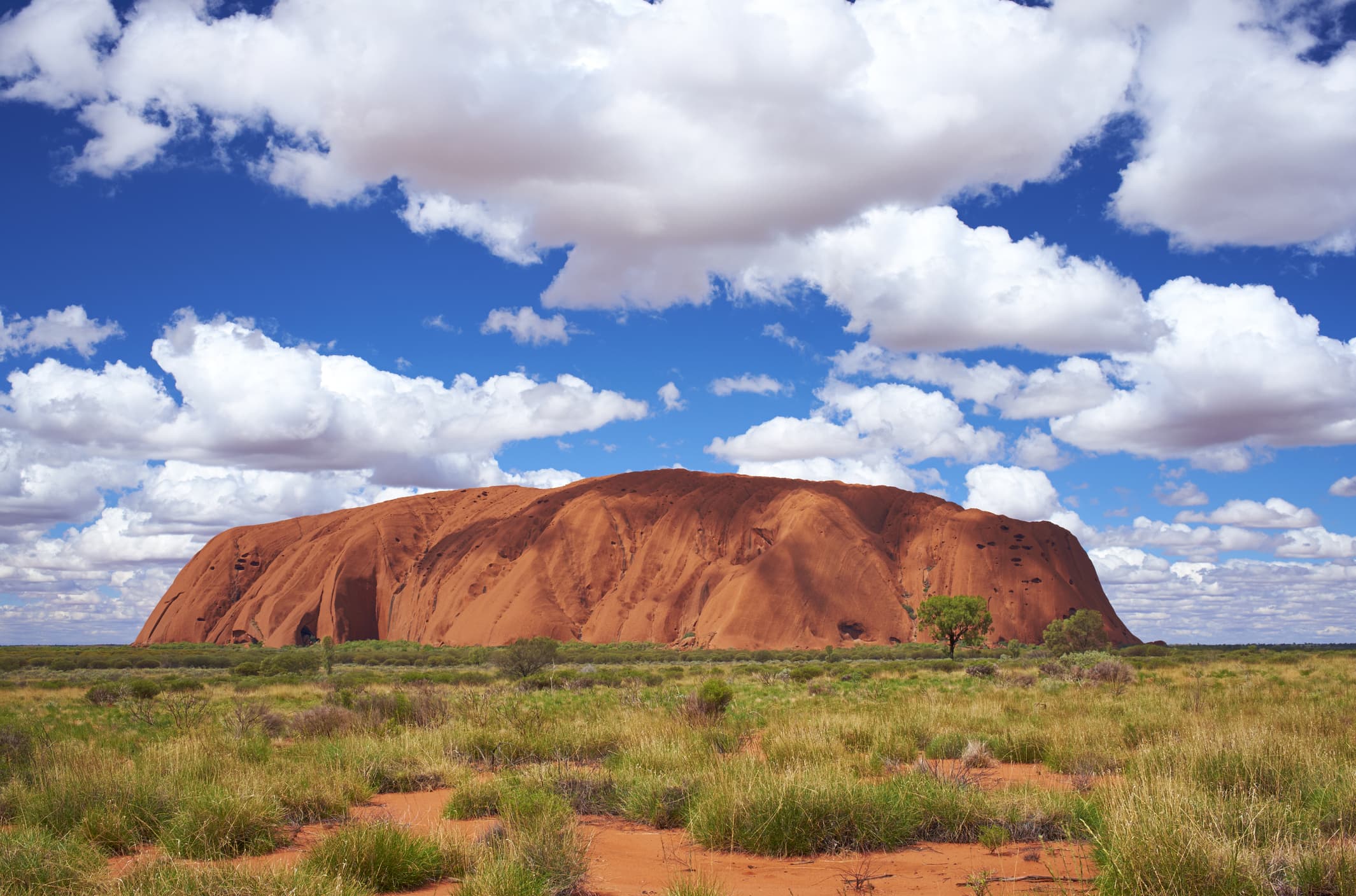Four things to do at Australia's Uluru monolith — besides climb it

Since Australia's rusty-red monolith, Uluru, was handed back to its original owners in 1977, the Anangu people have welcomed visitors to walk its 9.4 kilometer (5.8 mile) circumference and soak up its spiritual presence. They've also been vocal about the fact they'd prefer people didn't climb Uluru, as this was seldom allowed in the past.
Eighty percent of tourists to Uluru-Kata Tjuta National Park respected the request, although the other 20% chose to haul themselves up the rock's 348-meter (1,141 feet) surface regardless. At least 35 climbers died while doing so.
The climbing ban was marked by a ceremony by the Anangu, the original owners of the land that is now part of Uluru-Kata-Tjuta National Park.
SAEED KHAN | AFP | Getty Images
Now, there's no longer a choice. On October 26 of this year, the park's Board of Management officially banned climbing on Uluru. In the weeks that followed, the chains installed in 1963 to help people climb the steep rock were removed and symbolically handed over to Anangu elders.
Regardless of what you call it — Uluru is also known as Ayers Rock — there are dozens of ways to experience all that is sacred about Uluru and the rest of Uluru-Kata Tjuta National Park. Here are just a few options.
Take in Uluru on two legs
Many visitors begin with a free, ranger-guided walk along the two-kilometer (1.2 mile) wheelchair-accessible Mala Walk. However, many Anangu suggest taking a slow exploration of the Tjukurpa Tunnel before setting out. Here, to the sounds of ceremonial songs, visitors can learn about the Anangu's laws, traditions and art. The guided Mala Walk departs at 8 a.m. or 10 a.m. daily, depending on the season. Photos aren't allowed for cultural reasons.
Climbing isn't necessary to appreciate the beauty of Uluru.
Tourism NT/Mitchell Cox
Walking all or part of Uluru's circumference is a memorable experience, not the least for the crevices, caves and rock art found there. Try the geologically-impressive Lungkata Walk for opportunities to touch the rock, while the North-East Face Walk passes a multitude of sacred sites.
The Uluru Birds app is a trusty companion that helps bird-watchers identify some of the park's 178 avian species. Later in the day, weary legs can rest during the free bush tucker journeys (a talk about native bush foods) held daily at Ayers Rock Resort.
Trade two legs for two wheels
Uluru offers plenty of options to swap two legs for two wheels. The most serene is cycling; hire a bike from the mobile truck at the Cultural Centre and pedal to spots like the Mutitjulu Waterhole, one of the few permanent water sources in the area.
Traverse the sandy park paths with Uluru Segway Tours.
bennymarty | iStock Editorial | Getty Images
Take to the sky
Most people come to the Uluru-Kata Tjuta National Park, a UNESCO World Heritage site, for its cultural and natural uniqueness, but for visitors desperate for adventure, Uluru delivers.
It's possible to see both Uluru and the domed formations of nearby Kata Tjuta by plane, or for an added thrill, by helicopter. Those needing an extra adrenaline rush can rock the sky with Skydive Uluru. The company offers dives from 10,000 or 12,000 feet — the latter with a longer free-fall period — for spectacular views of "The Red Centre" of Australia.
Uluru, from above.
ullstein bild | ullstein bild | Getty Images
Getting out at night
A lot of time and energy goes into seeing Uluru at sunrise or sunset. But here, darkness doesn't always signal sleep. Photo buffs can learn the art of astrophotography from award-winning photographers. And, a four-night workshop gives after-hours access to the park.
After dark, learn the art of astrophotography at Uluru Kata Tjuta National Park.
swissmediavision | iStock Unreleased | Getty Images
Those content to keep their cameras focused on earth will appreciate the many ways to experience artist Bruce Munro's internationally-acclaimed Field of Light display, where 50,000 glass spheres come alive after dark.
The exhibition is so popular that its ending date has been indefinitely extended.
Read More
Hello everyone on here my name is Fumo Sadiku living in Malindi City Kenyan I want to tell a little more about a good hearten man called Benjamin Breil Lee working with funding service as loan officer, Mr Benjamin Breil Lee helped me get a loan of 37,115,225.00 Shillings on my trying time trying to get back on my feet to raise my business I know there are some of you here who are in financial difficulties to talk to Mr Benjamin on what's app +1-989-394-3740 Or also with his personal E-mail on 247officedept@gmail.com I'm so glad for what he did for me and for his Bank accountant as well Accountant Hernandez Lucas Thank you very much for your work well done.
ReplyDelete